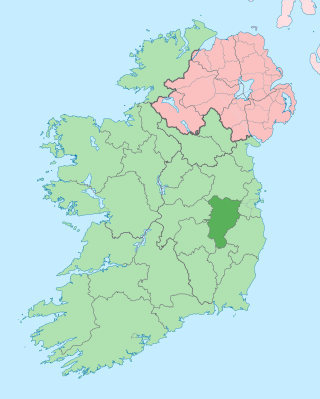
County Kildare is a county in Ireland. It is in the province of Leinster and is part of the Eastern and Midland Region. It is named after the town of Kildare. Kildare County Council is the local authority for the county, which had a population of 246,977 at the 2022 census.
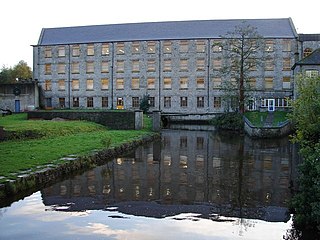
Celbridge is a town and townland on the River Liffey in County Kildare, Ireland. It is 23 km (14 mi) west of Dublin. Both a local centre and a commuter town within the Greater Dublin Area, it is located at the intersection of the R403 and R405 regional roads. As of the 2022 census, Celbridge was the third largest town in County Kildare by population, with 20,601 residents.

Blessington, historically known as Ballycomeen, is a town on the River Liffey in County Wicklow, Ireland, near the border with County Kildare. It is around 25 km south-west of Dublin, and is situated on the N81 road, which connects Dublin to Tullow.

Castletown House, Celbridge, County Kildare, Ireland, is a Palladian country house built in 1722 for William Conolly, the Speaker of the Irish House of Commons. It formed the centrepiece of an 800-acre (320 ha) estate. The estate was sold in 1965, and later sub-divided. The house and a core demesne of 120 acres were bought by a group of people looking to preserve them, and became the first major project of the Irish Georgian Society; they were later transferred to a dedicated charitable foundation, and ultimately to State ownership. Most of the wider estate remaining was divided between State forestry company, Coillte, and developers, and parts were built on, notably the former orchard and walled garden. In September 2023, the main access road and car parking became the subject of access issues and protests.
The year 1729 in architecture involved some significant events.

Celbridge is a Gaelic Athletic Association club in Celbridge, County Kildare, Ireland. They were awarded Kildare GAA club of the year in 2008, winners of the Kildare senior football championship of 2008, finalists in the senior football league of 1923, 1988 and 2008 and won the Kildare senior hurling and camogie championships in 2005. The club has also won several honours at underage levels in all three codes, qualifying for national finals in football, hurling and camogie at the 2008 Féile.
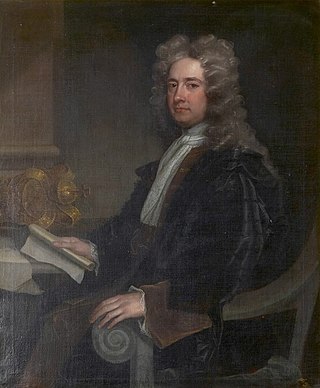
William Conolly, also known as Speaker Conolly, was an Irish Whig politician, Commissioner of Revenue, lawyer and landowner. He was an influential figure in Irish politics, serving as Speaker of the Irish House of Commons between 1715 and his death.
Events from the year 1729 in Ireland.

Educate Together is an educational charity in Ireland which is the patron body to "equality-based, co-educational, child centred, and democratically run" schools. It was founded in 1984 to act as the patron body for the new multidenominational schools that opened after the establishment of the Dalkey School Project. As of 2019, Educate Together is the patron of 90 national schools in Ireland. In 2014 three Educate Together Second Level Schools opened in Dublin 15, Drogheda and Lucan along with the first Educate Together school outside Ireland, in Bristol in the United Kingdom. In joint patronage with Kildare and Wicklow ETB, Educate Together opened another second-level school, Celbridge Community School, in 2015.
Arthur Price was Church of Ireland Archbishop of Cashel from 1744 until his death. Previously he had been Church of Ireland Bishop of Clonfert (1724–1730), Ferns and Leighlin (1730–1734) and Meath (1734–1744).
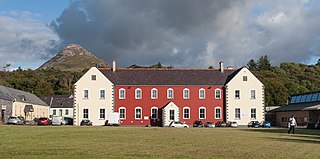
Industrial schools were established in Ireland under the Industrial Schools (Ireland) Act 1868 to care for "neglected, orphaned and abandoned children". By 1884, there were 5,049 children in such institutions throughout the country. The Act was superseded by the Children Act 1908.
The 2010 Ashbourne Cup inter-collegiate camogie championship was staged at the Cork IT sports complex in Bishopstown, Cork over the weekend of 20–21 February. It was won by Waterford Institute of Technology who defeated University College Cork in the final by two points, a repeat of the pairing and result, though not the margin of victory, of the 1999 final. Player of the tournament was WIT's Katrina Parrock.

Leixlip is a town in north-east County Kildare, Ireland. Its location on the confluence of the River Liffey and the Rye Water has marked it as a frontier town historically: on the border between the ancient kingdoms of Leinster and Brega, as an outpost of The Pale, and on Kildare's border with County Dublin. Leixlip was also a civil parish in the ancient barony of Salt North.

Colonel Thomas de Burgh, always named in his lifetime as Thomas Burgh, was an Anglo-Irish military engineer, architect, and Member of the Parliament of Ireland who served as Surveyor General of Ireland (1700–1730) and designed a number of the large public buildings of Dublin including the old Custom House (1704–6), Trinity College Library (1712–33), Dr Steevens' Hospital (1719), the Linen Hall (1722), and the Royal Barracks.

William James Conolly was an Irish landowner and Whig politician who sat in the Irish House of Commons from 1727 to 1754 and in the British House of Commons from 1734 to 1754.

Thomas Conolly was an Irish landowner and Member of Parliament.
Thomas Marlay was an Irish politician and judge, who ended his career as Lord Chief Justice of Ireland. He is remembered chiefly for beginning the rebuilding of Celbridge Abbey, and as the grandfather of the statesman Henry Grattan.

The Kildare Street Club is a historical member's club in Dublin, Ireland, at the heart of the Anglo-Irish Protestant Ascendancy.

Tea Lane Graveyard is a Christian cemetery located in Celbridge, Ireland.
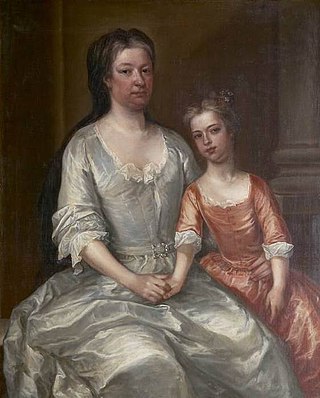
Katherine Conolly was an Irish political hostess, landowner, and philanthropist.














